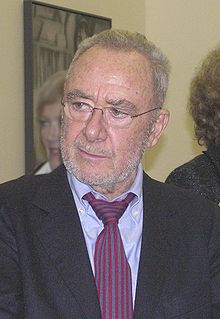Gerhard Richter
| Gerhard Richter | |
|---|---|

Gerhard Richter, 2005
|
|
| Born |
9 February 1932 Dresden, Weimar Republic |
| Nationality | German |
| Education | Dresden Art Academy, Kunstakademie Düsseldorf |
| Known for | Painting |
| Movement | Capitalist realism |
|
|
|
|
|
Gerhard Richter (German: [ˈʀɪçtɐ]; born 9 February 1932) is a German visual artist. Richter has produced abstract as well as photorealistic paintings, and also photographs and glass pieces. His art follows the examples of Picasso and Jean Arp in undermining the concept of the artist's obligation to maintain a single cohesive style.
In October 2012, Richter's Abstraktes Bild set an auction record price for a painting by a living artist at $34 million (£21 million). This was exceeded in May 2013 when his 1968 piece Domplatz, Mailand (Cathedral square, Milan) was sold for $37.1 million (£24.4 million) in New York. This was further exceeded in February 2015 when his painting Abstraktes Bild sold for $44.52 million (£30.4 million) in London at Sotheby's Contemporary Evening Sale.
Richter was born in Hospital Dresden-Neustadt inDresden, Saxony, and grew up in Reichenau, Lower Silesia (now Bogatynia, Poland), and in Waltersdorf (Zittauer Gebirge), in the Upper Lusatian countryside, where his father worked as a village teacher. Gerhard's mother, Hildegard Schönfelder, at the age of 25 gave birth to Gerhard. Hildegard's father, Ernst Alfred Schönfelder, at one time was considered a gifted pianist. Ernst moved the family to Dresden after taking up the family enterprise of brewing and eventually went bankrupt. Once in Dresden, Hildegard trained as a bookseller, and in doing so realized a passion for literature and music. Gerhard's father, Horst Richter, was a mathematics and physics student at the Technische Hochschule in Dresden. The two were married in 1931.
After struggling to maintain a position in the new Nationalist Socialist education system, Horst found a position in Reichenau. In Reichenau, Gerhard's younger sister, Gisela was born in November 1936. Horst and Hildegard were able to remain primarily apolitical due to Reichenau's location in the countryside. Horst, being a teacher, was eventually forced to join the National Socialist Party. He never became an avid supporter of Nazism, and was not required to attend party rallies. In 1942, Gerhard was conscripted into the Deutsches Jungvolk, but by the end of the war he was still too young to be an official member of the Hitler Youth. In 1943 Hildegard moved the family to Waltersdorf, and was later forced to sell her piano. He left school after 10th grade and apprenticed as an advertising and stage-set painter, before studying at the Dresden Academy of Fine Arts. In 1948, he finished higher professional school in Zittau, and, between 1949 and 1951, successively worked as an apprentice with a sign painter and as a painter. In 1950, his application for study at the Dresden Academy of Fine Arts was rejected as "too bourgeois". He finally began his studies at the Dresden Academy of Fine Arts in 1951. His teachers were Karl von Appen, Heinz Lohmar and Will Grohmann.
...
Wikipedia
